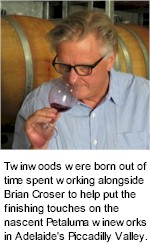


Thirty kilometres north of Margaret River township, regarded as the prime growing area for Cabernet Sauvignon, six superior acres of Cabernet Sauvignon and six of Shiraz were established in the early 1990s. Nine more acres of Cabernet Vineyard followed, more land has since been set aside for future planting. The vineyard is managed to principles of minimal chemical inputs, without the use of any mineral fertilisers. Irrigation from the estate dam is only called upon when conditions dictate that the vines need some supplementary water. Production is limited to 3 red wines made from Estate grown grapes including the flagship Optivus. The focus is Cabernet Sauvignon with the production of an Estate wine, made to reflect the location, in a style which is elegant, great palate texture and length. The wine is made in a style which allows it to be consumed while still young, while also offering the capacity to age.

Twinwoods Shiraz is planted on a portion of the vineyard which is slightly more protected and slightly cooler, this site in combination with the clones which were selected, produce a more elegant style Shiraz which has pepper, clove and olive aromatics and with a soft textured palate. Twinwoods Chardonnay comes from vineyards planted near the township of Margaret River which is cooler and therefore better suited to the variety. The vineyard is planted to the clone known as Mendoza which is recognised as giving the most complex and complete flavour profile. All the wines are matured in French oak Chateau Ferre barriques for 15 to 18 months, during which period it is subjected to three or four rackings. The amount of new oak used is determined by the structure of each vintage and ranges from 45 to 100%
Twinwoods were born out of time spent working alongside Brian Croser to help put the finishing touches on the nascent Petaluma wineworks in Piccadilly Valley. A few more years at the University of Adelaide and Charles Sturt completed the career transition to winemaking. After a few intense years amongst the grand old vineyards of Europe, a fruitful partnership in 2005 between winemaker Aldo Bratovic and Gavin Jones of Jebsen Fine Wines, lead to the establishment of Twinwoods Estate in Margaret River. Throughout 35 years of a distinguished career in the wine industry, Twinwoods can be proud of service as senior wine judge in significant Australian and International wine competitions, councillor Australian Wine Export Council, Chairman Japan Exports Committee, President of The Adelaide Hills Wine region, export judge Australian Wine and Brandy compliance section.
























